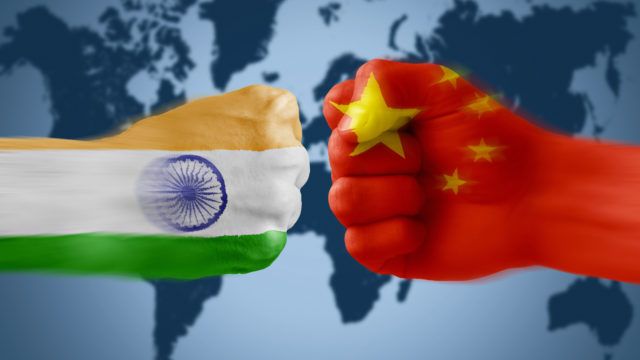
China and India are the two emerging market behemoths, although they have fared markedly differently in the past couple of years.
While China has been hurt by geopolitical tensions with the US, a regulatory clampdown on the tech sector, an all-encompassing property crisis and the country’s zero-Covid policy, India has emerged as a surprising investment hotspot during the same period.
India has managed the Covid-19 crisis far better than had been initially expected with the government eschewing the sort of fiscal largesse that has characterised the country’s response to previous crises, while fears that their economy would be derailed by higher commodity prices – the country is a larger net importer of coal – have proved unfounded as inflation has remained stubbornly high but within the Bank of India’s target range.
This divergence represents a remarkable reversal in outcomes from previous years as India has historically tended to lag its northern neighbour as the engine of emerging market growth. Although, this reversal has come at a cost as investors have abandoned China en masse for India, thereby driving up valuations.
According to its most recent factsheet, the MSCI China index is currently trading at a price-to-forward earnings ratio of 11.78x compared with a ratio of 21.43x for its equivalent Indian benchmark.
Some investors have argued that the sell-off of Chinese stocks has gone too far and India, in contrast, is now overpriced. With China recently easing some of its Covid-19 restrictions, share prices have begun to rally there as well, providing potentially an entry point for investors that have waited on the sidelines until now.
Against this backdrop, Darius McDermott, managing director at Chelsea Financial Services & FundCalibre, chose the Invesco China Focus Equity and Goldman Sachs India Equity Portfolio funds for comparison for this week’s head-to-head.
| Goldman Sachs | Invesco | |
| Size | $2.08bn | $292.5m |
| Inception | 2012 | 2017 |
| Managers | Hiren Dasani | Mike Shiao |
| Three-year cumulative return | 13.62% | -7.28% |
| Three-year annualised return | 13.36% | -5.63% |
| Three-year annualised alpha | 3.47 | -2.71 |
| Three-year annualised volatility | 23.18 | 25.99 |
| Three-year information ratio | 0.77 | -0.30 |
| Morningstar star rating | **** | *** |
| Morningstar analyst rating | n/a | n/a |
| FE Crown fund rating | *** | * |
| OCF (retail share class) | 1.93% | 2.14% |
Investment approach
The Invesco fund, which invests in companies in Hong Kong and Taiwan in addition to mainland China, aims to identify companies with a competitive advantage versus their peers and specifically targets companies the manager feels are undervalued by about 25%-30%. The aim is to hold them on the expectation they will reach fair value within three to five years.
The fund is able to invest in companies of any size but because the manager tends to eschew state-owned companies, the fund tends to be underweight larger companies and has a bias towards medium-sized ones. It also tends to be underweight smaller companies and unquoted stocks.
The fund has a sizeable exposure to the healthcare sector, which McDermott notes is largely because China, unusually for an emerging market, has an ageing population. The resulting portfolio is concentrated at only around 45 names.
“The philosophy is simple – strong returns are earned over time by investing in sound businesses at a substantial discount to intrinsic value.”
Darius McDermott, Managing Director, Chelsea Financial Services & FundCalibre
Meanwhile, the Goldman Sachs fund is an all-weather India fund, aiming to keep the majority of risk in stock selection rather than other non-stock specific factors such as market timing, beta, sector or other such exposures.
“He (the fund manager) may choose, at times, to tolerate some of these factor risks (for example, being overweight mid and small-cap stocks relative to the benchmark), as opposed to seek them, but only if such risks are a by-product of conscious decisions to optimise stock-specific alpha,” said McDermott.
“The philosophy is simple – strong returns are earned over time by investing in sound businesses at a substantial discount to intrinsic value.”
Stocks are held for a long time as demonstrated by the fund’s low turnover, which is around 20%. The fund has a much greater number of holdings than the Invesco fund at 99. It also has had a bias towards financials, consumer products and TMT, McDermott noted.
Sector allocation
| Goldman Sachs | Invesco | ||
| Financials | 25.8% | Retail | 18.1% |
| Information Technology | 14.3% | Media & Entertainment | 14.1% |
| Consumer discretionary | 12.4% | Banks | 13.8% |
| Materials | 10.7% | Consumer durables & apparel | 9.3% |
| Consumer staples | 8.3% | Food, beverage & tobacco | 7% |
| Industrials | 7.1% | Materials | 6.4% |
| Healthcare | 6.1% | Pharmaceuticals, biotechnology & life sciences | 4.8% |
| Energy | 4% | Healthcare equipment & services | 4% |
| Communication Services | 3.6% | Others | 21.8% |
| Future | 2.4% | Cash | 0.7% |
| Real estate | 2.4% | ||
| Other | 2.2% | ||
| Cash and cash equivalents | 0.7% |
Country allocation
| Goldman Sachs | Weighting | Invesco | Weighting |
| n/a | n/a | China | 84.8% |
| n/a | n/a | Taiwan | 8.9% |
| n/a | n/a | Hong Kong | 5.6% |
Top 5 holdings
| Goldman Sachs | Weighting | Invesco | Weighting |
| ICICI Bank | 7.6% | Tencent Holdings | 9.8% |
| Infosys | 7.3% | Alibaba Group Holding | 9.3% |
| Axis Bank | 5% | JD.com | 5.7% |
| Reliance Industries | 4% | China Merchants Bank | 4.8% |
| Bharti Airtel | 2.9% | China Construction Bank Corp | 4.6% |
Performance
The two funds are markedly different, which is reflected in their performance. The Invesco fund has lost 17% over the past three years, versus a return of -2% for the sector. In contrast, it has outperformed in the past 12 months, beating the average peer by almost six percentage points.
Meanwhile, the Goldman Sachs fund has produced a 46% return over the past three years, beating its average peer by a significant 15 percentage points. Over the past 12 months, the fund has fallen just over 10%, in line with the sector average.

“We’d expect performance to be tied to the outlook of the respective countries they invest in – both are large enough not to be dictated to by wider emerging market threats,” said McDermott.
“This will change regularly but given the overhanging threats in China (government intervention, geopolitical concerns) and the fact the fund has fewer holdings, you’d expect the Invesco fund to be a bit riskier in this environment.”
McDermott also noted that both funds are not particularly cheap, although they are not out of sync with their peers. The Invesco fund has an ongoing charge of 2.14%, while the Goldman Sachs fund charges 1.93%.
Manager review
The Invesco fund is led by Mike Shiao, who comes with good pedigree having joined Invesco in 2002. He worked his way up from his first position in Taiwan to become the Hong Kong-based chief investment officer for Greater China in 2015, leading the Greater China equities team, and a year later chief investment officer for Asia ex-Japan.
Meanwhile, the Goldman Sachs fund is led by Hiren Dasani, who is co-head of Goldman Sachs Asset Management’s emerging markets equity team and a portfolio manager for its emerging markets equity and India equity strategies. He joined the firm in 2007 from SSKI Securities.
Both portfolio managers come with ample support, according to McDermott. Shiao is supported by a team of 20 analysts, structured across multiple regions, but with defined industries to allow them to choose the best company available to them, while Goldman Sachs has a large investment team based in Asia, he noted.
Conclusion
Morningstar gives the Invesco fund three stars, while the Goldman Sachs fund is awarded four stars. Meanwhile, FE Fundinfo, which bases its assessment on a fund’s three-year history of delivering alpha, minimising relative volatility and producing consistent returns, gives the Invesco fund one crown and three crowns to the Goldman Sachs fund.
“Both are good funds – so this is all about risk appetite and investment horizons. If you are a cautious investor, I’d lean towards the tailwinds backing India, and the fact this fund has such a wide remit for investing. While valuations are not cheap, these will not be a concern over the longer-term (five years plus),” said McDermott.
“By contrast, China is not for the faint hearted. You have to prepare yourself for many bumps in the road on your investment journey. But there are signs that the zero-Covid policy is being relaxed and valuations have been battered to the point where they look extremely attractive versus history. I’d expect great returns from China over the next decade or so from this low point.”

















